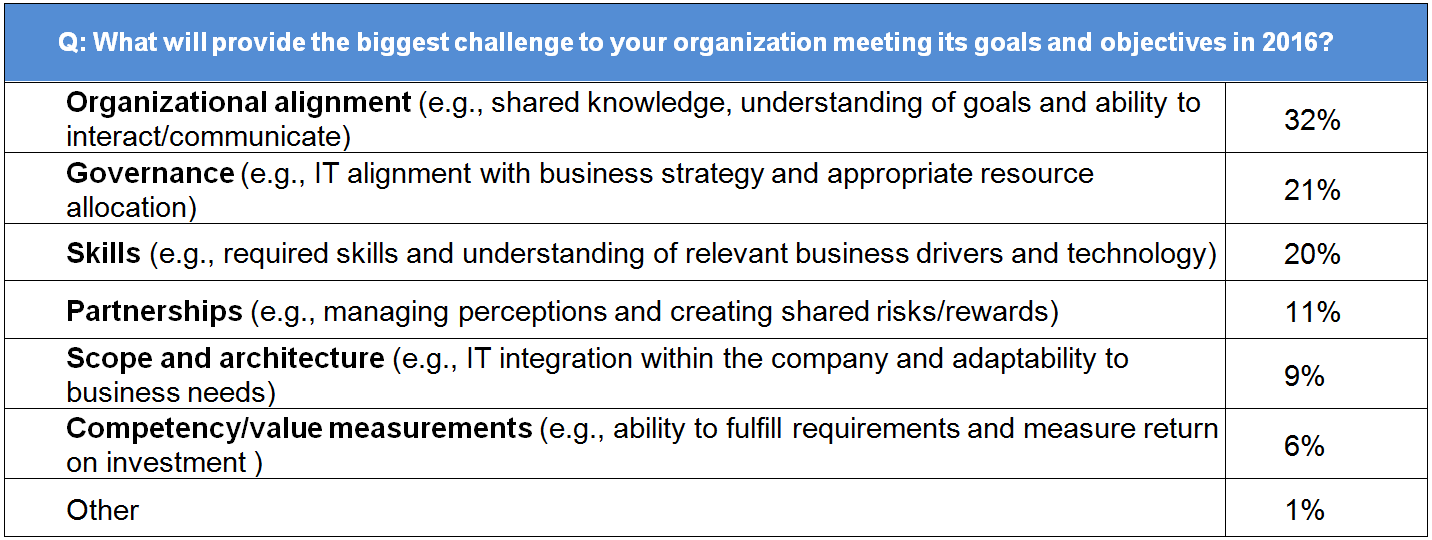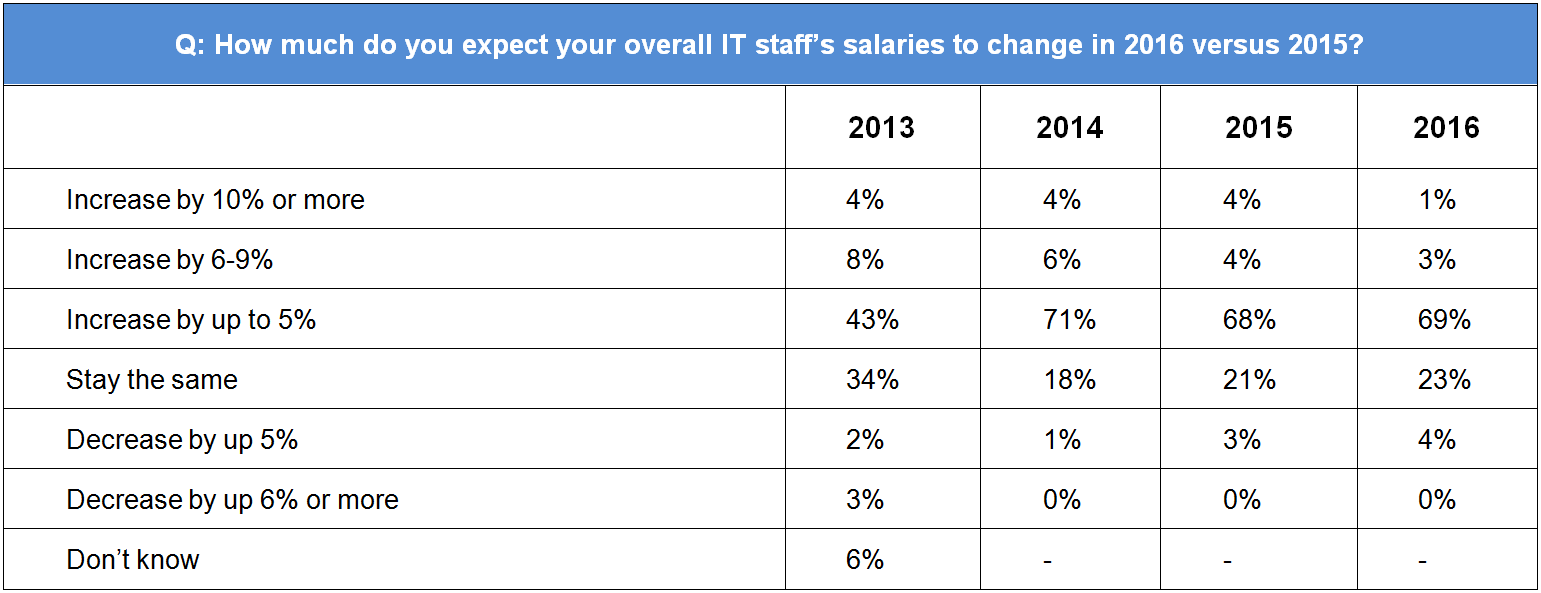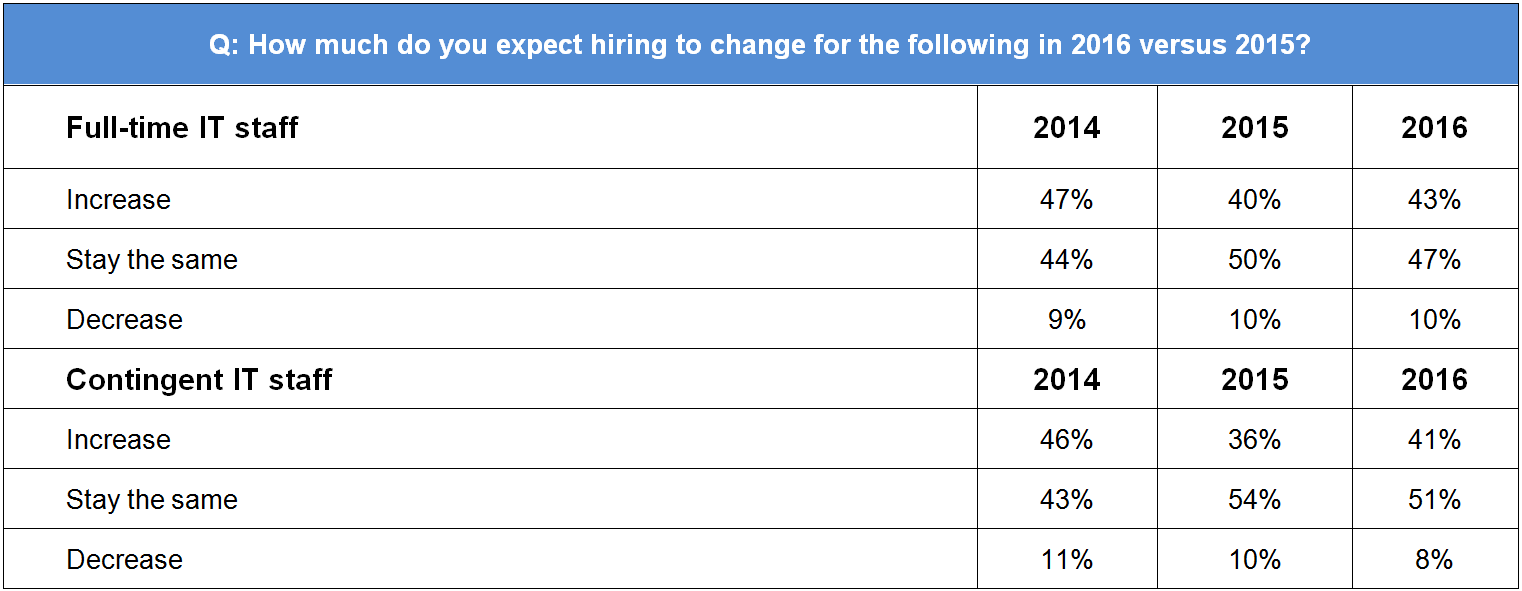IT 2016: Lower Expectations for Budget Increases; Leaders Begin to Doubt IT’s Ability to Support Overall Organizational Objectives
Dec 8, 2015 | HANOVER, MD | For media inquiries, please contact us at media@TEKsystems.com.
Hanover, Md. – Dec. 8, 2015 – TEKsystems®, a leading provider of IT staffing solutions, IT talent management expertise and IT services, today released its annual research which highlights lower expectations for IT budget increases and concern about supporting decentralized technology initiatives. More than 500 IT leaders (i.e., chief information officers, IT vice presidents, IT directors, IT hiring managers) were polled in Oct. 2015 on their expectations for IT spending, skills needs and organizational challenges in 2016. See the full results here.
Key highlights from the survey include:
Expectations for Budget Increases Continue Year-over-Year Drop; IT Funding Becomes Decentralized

 TEKsystems’ Take: The percentage of IT leaders who expect budget increases is at its lowest level since TEKsystems’ first annual IT Forecast survey for 2013. Additionally, it appears that IT spending is moving beyond the control of the IT department with 58 percent of IT leaders expecting other functional areas to spend the most on technology in 2016. As a result, organizational alignment is cited as the biggest challenge IT leaders expect to face next year.
TEKsystems’ Take: The percentage of IT leaders who expect budget increases is at its lowest level since TEKsystems’ first annual IT Forecast survey for 2013. Additionally, it appears that IT spending is moving beyond the control of the IT department with 58 percent of IT leaders expecting other functional areas to spend the most on technology in 2016. As a result, organizational alignment is cited as the biggest challenge IT leaders expect to face next year.
Confidence in IT’s Ability to Meet Overall Organizational Technology Demands Diminishes for the First Time in Four Years

 *Overall organizational demands are comprised of core IT and line of business demands
*Overall organizational demands are comprised of core IT and line of business demands
- TEKsystems’ Take: For the first time in four years, IT leaders’ confidence in IT’s ability to meet overall organizational demands declined. While more than 7 out of 10 IT leaders express confidence in their ability to satisfy core IT demands, their lack of control over decentralized technology efforts appears to raise concerns regarding their ability to support line of business (LOB) demands and new initiatives.
Organizational Alignment Cited as Biggest Challenge

- TEKsystems’ Take: The decentralization of IT budgets and technology investments outside of the IT department generates a new set of challenges. While it may lessen the burden on IT departments to financially support LOB- or marketing-driven technology initiatives, it creates additional coordination concerns that could lead to larger issues.
IT Priorities Consistent Year over Year; Majority of IT Leaders Still Expect to Invest in Security, Mobility and Cloud


- TEKsystems’ Take: For the past four years, IT leaders listed security, business intelligence (BI) / Big Data, cloud computing and mobility among the top five areas impacting their organizations. The consistency of these impact areas over the years explains why IT leaders’ confidence in supporting core IT demands continues to be strong. In 2016, networking is expected to enter the top five organizational impact areas, likely driven by the acceleration of ubiquitous computing, growth of wireless networks and emergence of Internet of Things (IoT) projects. While overall budget growth may be decelerating, IT leaders appear to be planning to allocate whatever increases they receive towards security, mobility and cloud, with the largest percentage of IT leaders anticipating budget increases in these areas.
Programmers and Developers Remain the Hardest to Fill Roles While Security Continues to Gain Ground; Salary Increases Decelerating
 *Positions that have been in the top five for four years running are bolded
*Positions that have been in the top five for four years running are bolded

- TEKsystems’ Take: From 2013 to 2016, IT leaders have consistently agreed on the most difficult position to fill, with programmers and developers maintaining the top spot. Security has consistently moved up in ranking from No. 7 (2013), No. 6 (2014), No. 5 (2015) to No. 2 (2016). These roles are also in line for salary increases; 53 percent of IT leaders predict higher salaries for programmers and developers with similar expectations for security experts (50 percent) and software engineers (47 percent). However, from 2014 to 2016, the percentage of IT leaders who expect to pay higher salaries for these skills (i.e., programmers and developers, security, and software engineers) decreased from an average of 67 percent (2014) to 53 percent (2015) to 50 percent (2016). While these roles are clearly still in high demand and salary increases are expected, the percentage of IT leaders who expect salary increases for these roles has declined over time.
Salaries and Hiring Will Continue to Rise, but at Slower Growth Rates; IT Staff Makeup will Remain Consistent



- TEKsystems’ Take: Average salary increases of up to 5 percent are expected, according to the majority (69 percent) of IT leaders. Only 4 percent of IT leaders expect salaries to increase by 6 percent or more and 23 percent expect salaries to remain the same. Hiring expectations are anticipated to increase slightly in 2016, though hiring for full-time IT staff is projected to marginally outpace hiring for contingent IT staff. As a result, the expected percentage of full-time staff as a proportion of the overall IT department gained slightly.
“With so much technology spend coming from areas outside of the IT department, it’s clear that IT leaders are taking into account the evolving nature of their responsibilities as they look to 2016,” says TEKsystems Research Manager Jason Hayman. “Organizational alignment will be their number one challenge, and essential for ensuring that the IT department is able to effectively support technology initiatives across LOBs and other functional areas, like marketing. Despite lower expectations for budget and salary increases, anticipated growth of full-time and contingent headcounts points to a healthy core IT team. However, IT leaders should be mindful that failure to properly adjust salaries in a competitive IT labor market will make it difficult to attract and retain the talent they need.”
TEKsystems’ Jason Hayman is available for additional commentary. For more information about the survey, or to schedule an interview, please contact Rick McLaughlin at TEKsystems@teamlewis.com.
About TEKsystems
People are at the heart of every successful business initiative. At TEKsystems, an Allegis Group company, we understand people. Every year we deploy more than 80,000 IT professionals at 6,000 client sites across North America, Europe and Asia. Our deep insights into IT human capital management enable us to help our clients achieve their business goals–while optimizing their IT workforce strategies. We provide IT staffing solutions and IT services to help our clients plan, build and run their critical business initiatives. Through our range of quality-focused delivery models, we meet our clients where they are, and take them where they want to go, the way they want to get there.